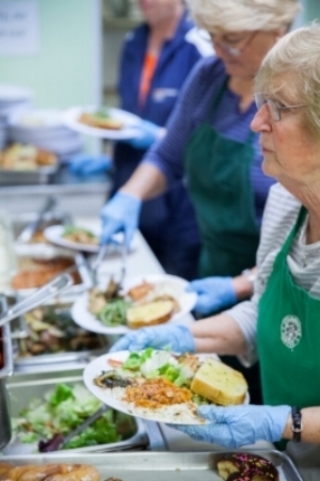When prepared food is dumped in the trash, or even composted, it’s not only the food, but the time and energy put into preparing it, that gets wasted. Instead of wasting this surplus, businesses across the country are donating hot prepared foods to nonprofit organizations, who can ensure that carefully crafted, nutritious meals feed the hungry instead. In Thurston County, Washington, nonprofits have been able to expand their impact by integrating donated food into their meal services, thereby decreasing waste, and feeding their community.
According to their Public Works Department, “In Thurston County, wasted food is the single-largest item currently going to the landfill.” With food insecurity at about 13%, and 1 in 6 households lacking adequate access to nutritional food, reducing food waste is a priority at both the state and local levels. The Community Kitchen, a program run by Catholic Community Services of Western Washington (CCS) in Olympia, is fighting hunger and reducing food waste through food recovery.
The Community Kitchen partners with multiple local food businesses to distribute recovered food to the residents of Thurston County and the surrounding areas. Bon Appétit Management Company (BAMCO) at Saint Martin’s University has been donating their surplus food to The Community Kitchen for many years, and became Food Recovery Verified in April 2014. According to Peter Epperson, the Community Kitchen’s Community Involvement Coordinator, these donations help to make their meal service possible, allowing them to serve three hot meals a day and provide bagged lunches seven days a week. Additionally, they deliver 325 meals to veterans in need at The Drexel House, and 100 meals to homeless youth at Rosie’s Place, every week.
It is possible to provide these meals thanks to the support of both state and local government agencies looking to divert food waste from landfills. According to Thurston County’s Solid Waste Program, in 2014, 17% of the county’s trash was food, and of that 43% was edible. To reduce the waste, they first granted funding to the Thurston County Food Bank so they could receive recovered food. A few years later, the Washington Department of Ecology backed this initiative by providing grant funding to eight agencies in Thurston County to grow their capacity to reduce food waste as well, one of which was The Community Kitchen. They used this funding to expand their walk-in cooler, to pay for food trays to package food, and to purchase reusable cambros in which to deliver it. These resources increased their kitchen’s capacity to support partnerships with food donors and accept larger volumes of donated food.
The Community Kitchen’s work would not be possible without their astounding volunteer base of nearly 650, some of whom have been volunteering in the area for 30 years.There are 30 crew leaders with food handling certifications, who organize recoveries, deliveries, and meal services. Remarkably, the rescued meals provided by the Community Kitchen are coordinated by just one chef, playfully nicknamed Turtle, who Epperson describes as, “ a whirlwind of joy and energy.” Turtle creatively repurposes recovered foods, and uses the fresh produce they rescue to provide healthy and nutritious meals.
Epperson recalls a meal made of rescued yakisoba noodles, fried vegetables and chicken recovered from Bon Appétit at Saint Martin’s University, paired with a green salad made of donated produce from Safeway.This is one example showcasing the quality and nutritional value of the food being donated. He notes that receiving prepared foods from Saint Martin’s recovery program has allowed them to donate more meals outside of the kitchen, since volunteers sometimes only need to pick up and deliver food that is ready to eat, as opposed to cooking and serving meals.
At one volunteer-run dinner that served 170 community members, one seven-year-old, who’s head barely reached the glass of the counter stood out. “She had this beaming smile on her face that radiated appreciation,” recalled Epperson, “all the while not knowing the food was rescued. From her perspective it was just good food.” Her smile serves as a testament to the hard work and love that Epperson sees in the staff at Bon Appétit. “Their mission in providing us with food, reflects their passion in feeding people,” Epperson elucidated, continuing with, “Just as the child beamed with gratitude for their meal, these people are also radiating, because they know that the hard work and the love that they put into their food is going to feed people that would otherwise go hungry.”
From state and local government support, down to the volunteers and chefs preparing and delivering recovered food, according to Epperson, what matters is that, “you can taste the love.”


